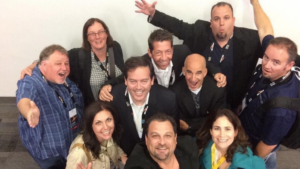I was excited and honored to sit down at the IBM Global Summit in Nashville with Jay Baer, a New York Times best selling author, a hype-free social media and marketing keynote speaker and consultant. Jay started 5 multi-million dollar companies, and consulted for 30 of the Fortune 500. His blog is ranked as the #1 content marketing blog in the world, the world’s #1 largest, most popular trend spotting website. In this interview we discuss how Jay looks at the differences between helping and selling. You’re not competing for attention only against other, similar products.
As Jay describes you’re competing for attention against everything. To win in this hyper-competitive environment, you must ask “How can we help?” If you sell something, you make a customer today, but if you genuinely help someone, you create a customer for life. This is Youtility. And if you haven’t had a chance to pick up his book Youtility on Amazon (already #9 on the New York Times)…..run to read this book, don’t walk.
“Youtility” as a concept, Y-O-Utility is marketing that is so useful people would pay for it and most marketing isn’t right? Most marketing benefits the company not necessarily the customers so we’re trying to flip that on it’s head and there are five blueprints we’re actually creating Youtility in a business.
The following interview has also been transcribed below:
INTERVIEW TRANSCRIPTION
Bryan: Let’s talk a little bit about the journey of the customer and how do you see that journey happening? How do you map that? Where does the ROI fit in? You know everyone is really asking that as marketers because they’re being held responsible for dollars now where before, I think you said this in a keynote, it’s really about brand awareness and being held responsible for the numbers. How do the two converge?
Jay: Yeah, the way I talked about it in the book and in the presentation is that if you sell something you create a customer today. But if you help someone you create a customer for life. That’s where Youtility fits in, right? You’re trying to, as they say, transcend the transactional. So you’re building relationships that are rooted in value and trust. And in so doing what you’re creating is higher repeat orders and, right up your alley, a greater propensity to advocate on behalf of the brand. It’s not just – wam bam thanks for your money we’re out. It’s we want to be a part of your life in a way that’s different than just – we’re a vendor for socks or whatever it is that you happen to sell.
Bryan: Sure, interested in the long term relationship. So talk to me about influencers and an influencer network. It’s so wide right now and yet it’s really only being tapped into about what 5-10% I’m guessing. But the amount of knowledge that’s out there in all the different industries that you can really tap into is pretty vast. How are we going to see that change over the next year?
Jay: Yeah. You know it’s funny. Not you, but often times I think companies confuse influence and audience, right? Okay well this person is an influencer. Well that may be true circumstantially but it’s not categorically true, right? Nobody is an influencer about everything. And so we’re starting to get a lot smarter I think about connecting influence at more of a granular level and make that a more efficient way to go. But what I’m interested in is this concept of information influencers right? That say, there’s people in your organization, and IBM is a great example of this – they’ve elevated people in the organization to be information influencers; to be thought leaders across Cloud or Smarter Commerce or any wide variety of IBM topics. And they’ve given them the tools to go out there and connect the dots mentally for not just customers but for prospective customers too, and that’s a playbook that any company can benefit from. There’s somebody at your local Dairy Queen who really gets the whole Dairy Queen thing. And why isn’t that person out there becoming a thought leader, creating content, having the how to run the best Dairy Queen blog? It works in every industry.
Bryan: So talk to me about how you create Youtility within yourself, within your personal brand, because that’s where it starts. Right? It starts there and you become more comfortable and move into the brand to be more comfortable online, to be more comfortable on social. How does that escalate?
Jay: Yeah I’m really glad to hear you say that Bryan because I don’t talk about that very much in the presentation, I don’t talk about it very much in the book. But indeed, the notion of Youtility as a personal construct not just a corporate construct I think is a really powerful concept and certainly something that I’ve tried to do in my life and my business for a long time. But part of it as we were just talking a moment ago, I think the foundation of that is recognizing that it’s a marathon not a sprint. I think where some people get cross wise is that they want to be useful they want to have a personal brand if you will that’s rooted in helpfulness but then they’re like you know what? I got to make sure I got to pay my mortgage this month right? So then it becomes, well I believe this but I’m not going to act upon that because I’ve got this external pressure that’s changing my behavior pattern. So a lot of it is just having the courage and the belief to say look, this is going to pay dividends eventually. Maybe not tomorrow, but eventually and that’s okay.
Bryan: Right. How now can that be reinforced from the brand standpoint? To help people influence, to help people become those internal advocates that then can become brand advocates, higher brand advocates to help the return customer. That can see that it’s working internally.
Jay: I think a very important operational element of that Bryan is that if you’re going to say to members of your team or company, we want you to go out there and be an influencer, we want you to be a thought leader, we want you to go out there and convey information that’s of interest to customers and prospective customers and business partners. You then have to give those people in your organization the time to go do that. What I see in a lot of cases is companies say, yeah we want you to, in addition to what you’re already doing, we want you to spend a significant amount of your time creating content and being a thought leader. And that’s neither fair nor effective. So if you want somebody, as part of their job, to go out there and connect those dots for people you’ve got to give them the opportunity to do that. You know that requires you to be thinking about what other responsibilities does this person have right? Because you know it takes a lot of time to do that well. It’s not something that’s like well, Thursdays from 10:00-10:07 I’m going to be a thought leader but then I got to go to the next meeting. But that’s what a lot of people are faced with in corporate situations right? It’s like, I don’t know when I’m going to have time to pull this off.
Bryan. Right. It certainly is an investment up front. So let’s talk a little bit about social media as a whole, marketing as as whole, public relations as a whole, and how the three fit together or don’t. You have a PR background I just heard earlier. Initially. So how do you see the three working together or not?
Jay: The line that I use in the book and in the presentation is that “Content is fire and social media is gasoline.” Right? That you’re much better off as a brand and frankly as an individual if you can use social media to promote your very useful information instead of using social media to promote your products and services directly. So this idea of “we’re awesome, click here to let us prove it” which is what a lot of tweets fundamentally say, and a lot of facebook status updates say that, a lot of blog posts say that.
Bryan: I saw an example that you showed.
Jay: Yeah, no one is ever going to gravitate towards that. So what we have to do is think of these, whether it’s earned, paid, owned, shared, traded, poets that acronym; we have to think of all of that as a unified system. And while I appreciate the paid, earned, owned sort of segmentation, I think it helps people understand modern marketing. I think it’s dangerous to oversegment. This is one thing and this other thing, and this is separate…because at the end of the day, from the customer’s perspective, it’s all just your brand. They don’t care whether it’s paid, owned, earned. It’s just what they see coming out of your mouth metaphorically. Right? So I think it’s a little bit dangerous to oversegment that way. We really need to start thinking about all of our brand communications as a holistic system. I think we’ll be better off.
Bryan: Great. Well, unfortunately we’ve run out of time here. I could sit here an talk to you all afternoon but…
Jay: Tomorrow, we’ll do it again tomorrow.
Bryan: …we’ve got things to do and thank you guys very much for joining us here at The Smarter Commerce Global Summit. We’re here with Jay Baer and we’ll see you soon.





